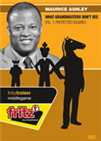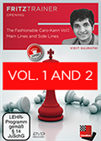Open Championship
What can one say about round four and the shock loss by Fabiano Caruana? In a sense it was a gratifying reminder that even the greatest players in the world can make the same mistakes beginners are warned against. It wasn’t a matter of overlooking a basic tactic or point by the opponent. The world no.2 seemed so caught up in his desire to win the game and take over the tournament, possibly to read a headline along the lines of “Faby wins again and is sole leader!” instead of the one that actually resides at the top.

It wasn't for lack of trying, but rather for trying too hard that Fabiano had to swallow the bitter pill of defeat at the hands of Zviad Izoria. | Photo: Austin Fuller
The Challenger came out swinging and full of gumption as he pressed forward against his much lower-rated opponent, but as Izoria explained after: he was not really intimidated, despite acknowledging Caruana’s superiority, since he did not have any real expectations. He played solidly and with resourcefulness, as demonstrated in the game. The warning signs to not overdo it were all there, but were not heeded and Fabiano’s stubbornness ended up costing him the point. Still, if that lesson needed reinforcing, then it might as well be here rather than at a crucial point in his forthcoming match.
Fabiano Caruana 0-1 Zviad Izoria

[Event "US-ch Men 2018"] [Site "Saint Louis"] [Date "2018.04.21"] [Round "4"] [White "Caruana, Fabiano"] [Black "Izoria, Zviad"] [Result "0-1"] [ECO "C54"] [WhiteElo "2804"] [BlackElo "2599"] [Annotator "Albert Silver"] [PlyCount "161"] [EventDate "2018.??.??"] [EventType "tourn"] [EventCountry "USA"] [SourceTitle "playchess.com"] [Source "ChessBase"] [SourceQuality "1"] [TimeControl "40/5400+30:1800+30"] 1. e4 {(0)} e5 {(18)} 2. Nf3 {(0)} Nc6 {(9)} 3. Bc4 {(0)} Bc5 {(39)} 4. c3 Nf6 {(24)} 5. d3 {(14)} d6 {(3:21)} 6. O-O h6 7. Re1 {(1:34)} O-O {(1:21)} 8. h3 { (1:57)} a5 {(2:05). A classic Giuoco Pianissimo in which Black tries to inhibit White's queenside expansion ideas of a4 and b4 with an early ...a5.} 9. Nbd2 a4 10. Nf1 {(1:46)} Bd7 {(5:11)} 11. d4 {(27)} Bb6 {(7)} 12. Ng3 {(58)} Re8 {(5:18)} 13. Bf1 {(8:10)} Qb8 {(6:51)} 14. d5 Ne7 {(2:23)} 15. Nh4 {(1:30)} Kh7 {(9:44)} 16. Qf3 {(3:39)} Qd8 {(1:07)} 17. Bd2 {(16:31)} Neg8 {0.41/19 (5: 05)} 18. Nhf5 $14 {(58)} g6 {(4:30)} 19. Ne3 {(59)} Kg7 {(28)} 20. Nc4 {(4:22)} Ba7 {(1:39)} 21. Be3 {(1:08)} Bxe3 {(11:02)} 22. Qxe3 {(41)} Nh7 {(7:53)} 23. f4 {(7:00)} b5 24. Nd2 exf4 {(11:02)} 25. Qxf4 {(5:28)} Qf6 {(1:50)} 26. Qe3 { (2:40)} Ne7 {(4:08)} 27. Qf3 {(7:04)} Rab8 {(3:42)} 28. a3 {-0.44/22 (7:42)} c5 {0.00/21 (37)} 29. Rad1 {( 12:27)} Nc8 30. Qe3 {(9)} Nb6 {(2:54)} 31. Nf3 { ( 24)} Ng5 {(36)} 32. Nh2 $1 {(9:09)} Nh7 33. Be2 Qg5 {(7:36)} 34. Qf2 {(57)} Qf6 {(8)} 35. Qe3 {(6:02)} Qg5 36. Qf3 {-0.67/20 (1:21)} Qf6 {0.00/20 (1:03)} ( {A more enterprising continuation for Black, who stands better here, might be} 36... h5 $15 {-0.67/20}) 37. Bd3 {-0.41/20 (7)} Qxf3 {(1:30)} 38. Nxf3 f6 {(18) } 39. h4 {(1:21)} h5 {(24)} 40. Kf2 {(1:41)} Nf8 {(31:24)} 41. Nd2 {-0.56/21 ( 06:50)} Nc8 $1 {[#] (0) A lovely idea, which should really have been a hint to Caruana that his opponent is not to be underestimated. Black plans to reposition the knight all the way to e5 if allowed, but g4 at the very worst via the maneuver Nc8-e7-g8-h6-g4. The position is fairly static at the moment so this sort of undertaking is perfectly feasible.} 42. Rb1 {(3:13)} Ne7 {(0)} 43. Ngf1 {(3:15)} Ng8 {(0)} 44. Ne3 Nh6 {(0)} 45. Be2 {-0.65/19 (5:20)} f5 {(0) } 46. b3 {(4:27) A strong move that Izoria admitted in the post-mortem that he had missed and was uneasy about.} axb3 {( 00)} 47. Rxb3 {(4)} c4 {(0)} ({ A mistake would be} 47... fxe4 $6 {and White can suddenly play} 48. Reb1 $14 { with certain recovery of the pawn with interest.} c4 $2 {would not be possible due to} 49. Ndxc4 $1 {and the pawn is pinned.}) 48. Rb4 {(5)} fxe4 {(0)} 49. Reb1 {(2:57)} Ra8 {[#] (0)} 50. a4 $1 {(5)} Rxa4 {(40)} 51. Rxa4 {(3)} bxa4 { ( 06)} 52. Ndxc4 {(4)} Nf7 {(42)} 53. Rb7 {(36). White stands a bit better thanks to his piece activity, but it is minimal due to the counterweight of the protected passed a-pawn.} Kf6 {(54)} 54. Bd1 {(2:44)} Ra8 {(4:37)} 55. Nb6 {(7)} Rd8 {(2)} 56. Nec4 {(1:14)} Bb5 {( 47)} 57. Nd2 {0.00/21 (1:02)} ({ Why not eliminate that thorn with} 57. Bxa4 $14 {0.50/21 ?} Bxa4 58. Nxa4) 57... Bd3 {(28)} 58. Ke3 $132 {(1:46)} Ne5 {(15)} 59. Bxa4 {(1:03)} g5 {(1:52)} 60. hxg5+ {(2:16)} Kxg5 {(2)} 61. Nxe4+ {(45)} Bxe4 {( 07)} 62. Kxe4 {(2)} Nfg6 {(12)} 63. Nd7 {(1:42)} Rc8 {(21)} 64. Bc6 {(2:27)} Nxc6 {(14)} 65. dxc6 {(3)} Rxc6 $11 {(12)} 66. Kd4 {(1:00)} Nf4 {( 46)} 67. c4 {(19)} Nxg2 {(51)} 68. Kd5 {(1:07)} Rc8 {(33). aiming for ...Ne3+.} 69. Nb6 $2 {-0.92/22 (42) White's refusal to let go, and take the draw finally catches up with him.} (69. Kxd6 $11 {0.00/26 remains equal.} Rxc4 70. Rb5+ Kh6 71. Ne5) 69... Ne3+ $1 $17 {(3)} 70. Ke6 {-1.68/21 [#] (3)} Rc6 $2 {0.00/24 (1:36) A mistake that might have cost him his edge.} ({Instead} 70... Rh8 $1 {-1.68/21 would have been completely winning for Black.} 71. Rg7+ Kf4 72. Nd5+ Nxd5 73. Kxd5 Rh6 $19) 71. Kd7 {-1.00/23 (1:10)} Nxc4 {( 11)} 72. Kxc6 $2 {-250.00/31 (11) This loses much quicker and makes Black's task easy.} (72. Nd5 {-0.80/19 would have offered more stubborn defence, though it still loses objectively after} Ne5+ 73. Ke6 Rc1 74. Rg7+ Ng6 75. Kxd6 {and here the tablebases annnounce mate in 50 for Black.}) 72... Na5+ $19 {(7)} 73. Kxd6 {(12)} Nxb7+ {(9)} 74. Kd5 {(39)} Kf4 {(27)} 75. Nc4 {(42)} h4 {(20)} 76. Nd2 {(10)} h3 {(1:13)} 77. Nf1 {(2)} Nd8 {(31)} 78. Kd4 {(1:03)} Nf7 {(25)} 79. Kd5 {(52)} Ne5 {(47)} 80. Kd4 {( 38) } Ng4 {(28)} 81. Kd3 {(6)} 0-1
A setback no doubt, but one that can easily be overcome. It was still satisfying seeing Caruana show so much spirit, and no one wants to see it diminished, just tempered with a bit of patience perhaps.
 Many times when a top player blunders, it is routinely described by the esoteric term „chess blindness.“ In the series What Grandmasters Don‘t See, chess trainer and world-class commentator Maurice Ashley strips away the myth, and for the first time explains why the root of these mistakes is more often based on the psychology of human learning.
Many times when a top player blunders, it is routinely described by the esoteric term „chess blindness.“ In the series What Grandmasters Don‘t See, chess trainer and world-class commentator Maurice Ashley strips away the myth, and for the first time explains why the root of these mistakes is more often based on the psychology of human learning.
In Volume 1 of the series, Ashley coins a new term Protected Squares, and shows how many errors occur on squares that seem invulnerable because they are clearly guarded by pawns.Still, this opened the way for others to grab a spot on the makeshift podium, and one player to seize his chance was Sam Shankland. Shankland faced Ray Robson, a player who is a constant danger to all his opponents. He is a very unconventional player with extremely resourceful and creative ideas, and as Shankland explained after, he has learned to be very careful about judging moves his own understanding would label as idiotic, since even with several such moves he has found himself lost against Robson in the past. This time, whatever the reality, the game did not go Ray’s way, and after a fairly smooth win, Shankland joined the leaders Wesley So and Varuzha Akobian, both of whom drew, with 3.0/4.

Ray Robson is renowned for his creativity and resourcefulness | Photo: Lennart Ootes
The youngest player among the men, GM Awonder Liang, was received with plenty of praise by the live commentators GM Maurice Ashley, WGM Jennifer Shahade, and GM Yasser Seirawan for his third draw. This might seem like a bit of irony either on their part or mine, but hardly. The reason is that those draws were against the top seeds in the event, the Big Three. In fact, in at least two of them, the young prodigy had not only emerged from the scuffle unscathed but with chances of his own for more. In fact, Awonder explained that having no prior experience against such players, he had been more than happy to play solid and take the draw, but now was beginning to feel a bit of regret for not trying for more. Still, his approach cannot be faulted and caution was the right course in such circumstances, He should have plenty of opportunities in the future to prove his worth, at the very least in a future US Championship.

WGM Jennifer Shahade and GM Yasser Seirawan have been a success story in helping make the live coverage so enjoyable to watch | Photo: Austin Fuller
Standings after four rounds
Games of round four
Women’s Championship
Frankly, the round four report on the US Women’s Championship could just as easily have been dubbed “White to play and win” considering the lopsided results of the day. Not only did all six games end in a decisive result, but five of them were wins by white. The one black sheep in that 'white' wash was Irina Krush’s victory with black over Maggie Feng.
Among the many fun games to watch, the first would have to be Nazi Paikidze’s impressive win over Anna Sharevich. Sharevich had enjoyed 15 minutes of fame with a swift win over Irina Krush, including a nice conclusion to boot, but today she was on the receiving end of a similar game. Their game began as a very unorthodox continuation in the Caro-Kann Two Knights, and Paikidze showed herself to not only be in a very belligerent mood, but an inspired one as well. A well-timed battering ram in Black’s centre and king with 18.d5! Left Black’s king stuck in the centre and the rook on d7 hopelessly pinned. It was an impressive performance by the 2016 champion, seeking a repeat of that success, and who continues to lead with 3½/4.
Nazi Paikidze 1-0 Anna Sharevich

[Event "US-ch Women 2018"] [Site "Saint Louis"] [Date "2018.04.21"] [Round "4"] [White "Paikidze, Nazi"] [Black "Sharevich, Anna"] [Result "1-0"] [ECO "B11"] [WhiteElo "2352"] [BlackElo "2281"] [Annotator "Albert Silver"] [PlyCount "57"] [EventDate "2018.??.??"] [EventType "tourn"] [EventCountry "USA"] [SourceTitle "playchess.com"] [Source "ChessBase"] [SourceQuality "1"] [TimeControl "40/5400+30:1800+30"] 1. e4 {(0)} c6 {(2:00)} 2. Nc3 {(0)} d5 {( 39)} 3. Nf3 {(0)} Bg4 {(4:36)} 4. h3 {(1:32)} Bxf3 {(3:26)} 5. Qxf3 {(7)} d4 {(2:09)} 6. Ne2 {0.06/20 (17)} e6 { 0.62/19 (14:12) Needless to say, this is already becoming higly unorthodox. The usual continuation is ...e5} 7. d3 {-0.21/20 (23:04)} Nf6 {0.40/20 (6:31)} (7... Qb6 8. a3 Nd7 9. Ng1 Bd6 10. Qe2 Ne7 11. Nf3 c5 12. g3 Nc6 13. Bg2 O-O 14. O-O Qc7 15. Bd2 Rfe8 16. b4 a6 17. Rfb1 Red8 18. bxc5 Nxc5 19. e5 Bxe5 { 1/2-1/2 (19) Pfretzschner,R (2546)-Brodda,W (2592) ICCF email 2011}) 8. g4 { -0.02/19 (1:25) Grabbing the bull by the horns. White is saying: If Black wants to play offbeat paths, then get ready and show what you're capable of.} Na6 {0.85/20 [#] (20:25)} 9. Bg2 {-0.12/19 (2:27)} ({White also had} 9. g5 $1 $16 {0.85/20} Nd7 10. Nxd4 Ne5 $14 {and here White has the surprising resource} 11. Qg3 $1 {and while Black wins the knight with} Qxd4 {White will recover it just as quick after} 12. c3 $1 Qd6 13. Bf4 f6 14. d4 {and White's advantage is not in doubt}) 9... Qa5+ {0.57/19 (1:29)} 10. c3 {0.10/21 (1:18)} Rd8 {(5:13)} 11. O-O {( 06:26)} dxc3 {(33)} 12. bxc3 {(1:33)} Nc5 {(29)} 13. d4 {(9:18)} Ncxe4 {(2:08)} 14. c4 {(8:05)} Nd2 {(7:12)} 15. Bxd2 $1 {(7)} Qxd2 {(5)} 16. Rfd1 {-0.10/19 (44)} Qg5 {0.46/20 (1:50)} 17. Qb3 $14 {(5:09)} Rd7 {(2:44)} 18. d5 $1 {(3:28)} cxd5 {(1:31)} 19. cxd5 {(5)} e5 {1.40/20 (53)} 20. Rac1 $16 { (2:37). White has strong compensation.} Be7 {(7:32). Black wants to play ... 0-0.} 21. Rc8+ {(7:11)} Bd8 {(57)} 22. Qa3 {(47)} h5 {(1:28)} 23. f4 $1 $36 { (1:59). White is showing her attacking chops.} exf4 {[#] (1:46)} 24. Nd4 $1 { (6:13). Re1+ is the immediate threat.} Qe5 $2 {3.46/18 (2:28) Black buckles almost immediately under the pressure.} ({The only move according to the engines is the completely bizarre} 24... Ng8 $1 $11 {0.00/17 after which White will be challenged to prove the attack is still going. Black's idea is to be able to cover the e7 square with the knight and develop the rook on h8 via the luft h6. But regardless, it is far easier to play as White and there is no question that the burden is on Black to walk the tightrope to safety.}) 25. Nf5 $18 {(24) With the threat of Nxg7 mate.} Nxd5 {10.88/19 (4:41)} 26. Bxd5 { (1:33)} Rxd5 {(34)} 27. Qa4+ {(15) And Black resigned in view of} b5 28. Qxb5+ $1 Rxb5 29. Rdxd8# 1-0
 The Caro Kann is a very tricky opening. Black’s play is based on controlling and fighting for key light squares. It is a line which was very fashionable in late 90s and early 2000s due to the successes of greats like Karpov, Anand, Dreev etc. Recently due to strong engines lot of key developments have been made and some new lines have been introduced, while others have been refuted altogether. I have analyzed the new trends carefully and found some new ideas for Black.
The Caro Kann is a very tricky opening. Black’s play is based on controlling and fighting for key light squares. It is a line which was very fashionable in late 90s and early 2000s due to the successes of greats like Karpov, Anand, Dreev etc. Recently due to strong engines lot of key developments have been made and some new lines have been introduced, while others have been refuted altogether. I have analyzed the new trends carefully and found some new ideas for Black.
Nazi Paikidze arriving at the venue in the photogenic surroundings | Photo: Lennart Ootes
Hers was not the only big result of the day as 15-year-old Annie Wang also overcame her fellow junior, Jennifer Yu, after a marathon 106 moves. Wang had started the game with an advantage, but eventually squandered it, almost getting into trouble herself, when Yu failed time and time again to draw the game safely, and finally went astray. As a result, Annie Wang continues to share the top spot with 3½/4.
Standings after four rounds
Games of round four
Correction: Awonder Liang scored three draws in the first four rounds, not four.
Links








